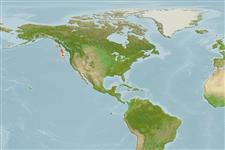Pycnogonida |
Pantopoda |
Ammotheidae
Environment: milieu / climate zone / depth range / distribution range
Ecology
Benthic; depth range 1570 - 2250 m (Ref. 2157). Temperate
Northeast Pacific: USA.
Length at first maturity / Size / Weight / Age
Maturity: Lm ? range ? - ? cm
Species without dorsomedian trunk tubercles and with very low, blind, ocular tubercle. Proboscis massive, constricted medially and distally; chelifores small. Palps of 9 segments, very setose distally as are distal segments of male oviger. Male legs with crowded filed of lateral and ventral setae on third coxae and proximally on femorae while legs of females lack dense fields of setae. Propodi bear similar sole and heel spines with no major or larger spines (Ref. 2157, p. 7).
Life cycle and mating behavior
Maturity | Reproduction | Spawning | Eggs | Fecundity | Larvae
Members of the class Pycnogonida are gonochoric and sexually dimorphic. During copulation, male usually suspends itself beneath the female. Fertilization occurs as the eggs leave the female's ovigers. Males brood the egg masses until they hatch. Life cycle: Eggs hatch into protonymphon larva then to adults.
Child, C.A. 1994 Deep-sea Pycnogonida from the temperate west coast of the United States. Smithsonian Contributions to Zoology 556:1-23. (Ref. 2157)
IUCN Red List Status
(Ref. 130435: Version 2025-1)
CITES status (Ref. 108899)
Not Evaluated
Not Evaluated
Threat to humans
Human uses
| FishSource |
Tools
More information
Trophic EcologyFood items (preys)
Diet composition
Food consumption
Predators
Population dynamicsGrowth
Max. ages / sizes
Length-weight rel.
Length-length rel.
Length-frequencies
Mass conversion
Abundance
Life cycleReproductionMaturityFecunditySpawningEggsEgg developmentLarvae PhysiologyOxygen consumption
Human RelatedStamps, coins, misc.
Internet sources
Estimates based on models
Preferred temperature
(Ref.
115969): 2.1 - 2.2, mean 2.2 (based on 5 cells).
Price category
Unknown.
